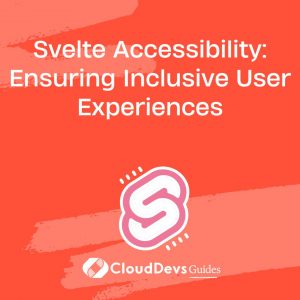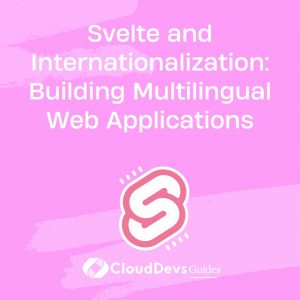Svelte Accessibility: Ensuring Inclusive User Experiences
In the fast-paced world of web development, creating websites and applications that cater to a diverse range of users is of paramount importance. As technology continues to evolve, ensuring that your digital products are accessible to everyone, regardless of their abilities, becomes a critical aspect of development. This is where the concept of web accessibility comes into play. In this blog post, we will delve into the realm of Svelte accessibility and explore how you can craft inclusive user experiences through thoughtful design and implementation.
1. Understanding Accessibility in Web Development
Web accessibility refers to the practice of designing and developing digital content in a way that can be easily accessed and used by individuals with disabilities. This includes people with visual, auditory, motor, and cognitive impairments. Accessibility is not just a legal requirement in many regions; it’s a moral obligation and a way to create a more inclusive digital environment.
When a website or application is accessible, it means that users of all abilities can navigate, understand, and interact with its content without facing barriers. This involves providing alternative text for images, ensuring proper keyboard navigation, offering captions for videos, and more.
2. Why Svelte Accessibility Matters
Svelte, a cutting-edge JavaScript framework, has gained significant traction for its innovative approach to building user interfaces. While creating stunning and performant UIs is a cornerstone of Svelte, considering accessibility from the outset is equally crucial. By building accessibility into the foundation of your Svelte applications, you can reach a wider audience and contribute to a more inclusive internet.
3. The Benefits of Prioritizing Accessibility
- Expanded User Base: When you make your Svelte applications accessible, you open the door to users who rely on assistive technologies such as screen readers, keyboard navigation, or voice commands.
- Legal and Ethical Compliance: Many countries have regulations in place that require digital products to meet certain accessibility standards. Prioritizing accessibility helps you avoid legal issues and aligns with ethical principles.
- Enhanced SEO: Search engines value accessible content, as it often implies well-structured and semantically meaningful information. This can lead to improved search engine rankings.
- Positive Brand Image: A commitment to accessibility reflects positively on your brand. It shows that you care about all users’ experiences and are dedicated to providing equal opportunities.
4. Key Techniques for Svelte Accessibility
Let’s explore some essential techniques to ensure your Svelte applications are accessible to a diverse user base.
1. Semantic HTML Elements
Using semantic HTML elements forms the basis of a well-structured and accessible website. Svelte provides an intuitive way to integrate semantic elements into your components. For example, instead of using a <div> for a button, you can use the <button> element, which conveys its purpose to both users and assistive technologies.
svelte
<button on:click={handleClick}>Click Me</button>
2. Managing Focus
Proper focus management ensures that keyboard users can navigate through your application seamlessly. Svelte offers the bind:this directive, which allows you to manage the focus of elements easily. For instance, you can focus on an input element when a modal opens:
svelte
<input bind:this={inputElement} type="text" />
{#if showModal}
<Modal on:close={() => showModal = false}>
<button on:click={() => {
inputElement.focus();
showModal = false;
}}>Open Modal</button>
</Modal>
{/if}
3. Providing Alternative Text
Include descriptive alt text for images to make your content accessible to visually impaired users. Svelte makes it straightforward to implement this:
svelte <img src="image.jpg" alt="A beautiful sunset over the mountains" />
4. Handling Dynamic Content
In Svelte, dynamic content can be rendered using {#each} blocks or conditional statements. Ensure that the content remains accessible by adding appropriate labels and roles. For example, when creating a list:
svelte
<ul>
{#each items as item (item.id)}
<li role="listitem">{item.name}</li>
{/each}
</ul>
5. ARIA Roles and Labels
ARIA (Accessible Rich Internet Applications) roles and labels provide additional information to assistive technologies about the purpose and functionality of UI elements. Svelte allows you to easily add ARIA attributes:
svelte
<button role="checkbox" aria-checked={isChecked} on:click={toggleCheckbox}>
Toggle Checkbox
</button>
5. Testing and Validating Accessibility
Ensuring accessibility requires thorough testing to identify and rectify potential issues. There are various tools available to evaluate the accessibility of your Svelte applications, such as:
- axe-core: An accessibility testing engine that can be integrated into your testing workflow.
- Lighthouse: A tool that evaluates the overall quality of your web application, including accessibility.
Conclusion
Creating inclusive user experiences is not just a goal; it’s an imperative for modern web development. By embracing Svelte accessibility techniques, you can build applications that cater to all users, regardless of their abilities. The synergy between Svelte’s innovative approach and accessibility principles enables you to craft digital products that are not only visually stunning but also genuinely inclusive. So, let’s embark on this journey of building a web that truly leaves no one behind.
Table of Contents








